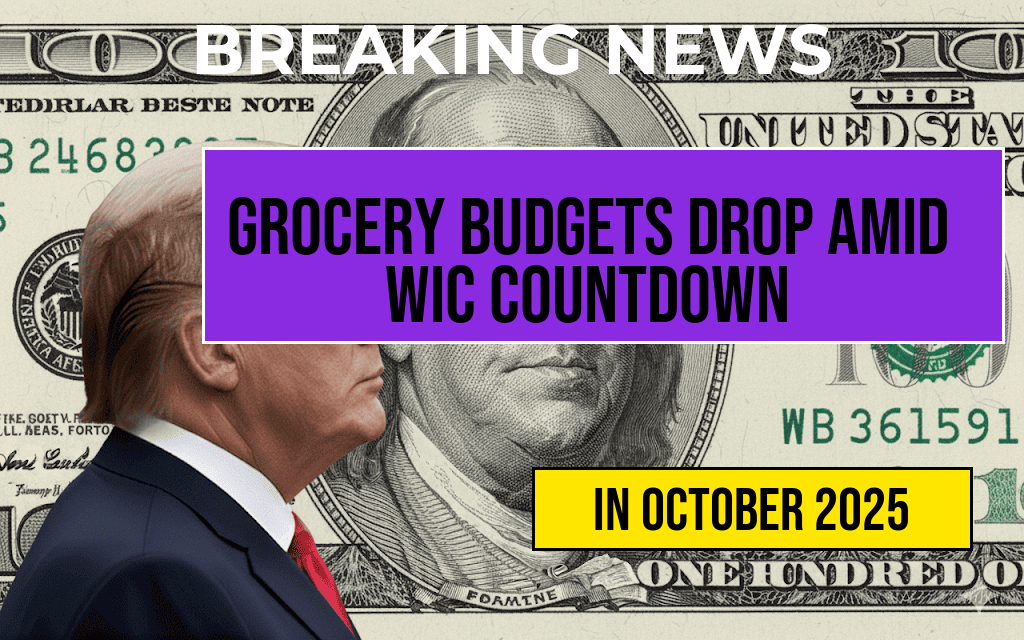As families across the nation prepare for their monthly grocery shopping, a recent analysis reveals a significant drop in grocery budgets, with expenditures plummeting between $26 and $78 monthly. This downturn comes as the Women, Infants, and Children (WIC) program faces a looming two-week deadline for funding renewal. As food prices remain volatile, many households, particularly those relying on government assistance, are feeling the pinch. Analysts suggest that the impending funding challenges could exacerbate food insecurity, especially for vulnerable populations who depend heavily on WIC benefits for nutritious meals.
Current Impact of WIC Funding on Grocery Budgets
The WIC program plays a critical role in supporting low-income families by providing access to healthy food options. However, with the upcoming funding discussions, many families are bracing for potential cuts. According to recent data, grocery budgets are already shrinking, with families reporting an average decrease of $26 to $78 in their monthly grocery spending. This decline reflects not only the uncertainty surrounding WIC funding but also the broader economic pressures affecting food prices.
Understanding the WIC Program
The WIC program, administered by the U.S. Department of Agriculture (USDA), is designed to safeguard the health of low-income women, infants, and children up to age five. The program provides food benefits, nutrition education, and health referrals. With around 6.2 million participants annually, the program has become an essential resource for many American families. However, as funding discussions approach, the potential for cuts could significantly impact these participants.
Economic Factors at Play
- Inflation Rates: Rising inflation has already placed pressure on grocery prices, making it more challenging for families to maintain their budgets.
- Supply Chain Issues: Ongoing supply chain disruptions continue to affect the availability and pricing of essential food items.
- Policy Changes: Uncertain government policies and funding allocations add another layer of complexity for families relying on aid.
Expert Opinions on Future Implications
Food economists and social policy experts are closely monitoring the situation. Dr. Jane Holloway, an economist at the University of California, stated, “If WIC funding is not renewed, we could see a substantial increase in food insecurity rates among vulnerable populations. This is especially concerning as many families have already been struggling to make ends meet.”
As grocery bills rise and WIC funding remains uncertain, experts urge policymakers to prioritize the program. “The health of our children and families is at stake,” Dr. Holloway added. “Investing in nutrition assistance programs like WIC is crucial for ensuring that everyone has access to the food they need.”
Potential Solutions for Affected Families
With the uncertainty surrounding WIC funding, families are seeking alternative strategies to manage their grocery costs:
- Meal Planning: Families are encouraged to plan meals ahead of time to reduce impulsive purchases and waste.
- Community Resources: Local food banks and community organizations can provide supplemental assistance for families in need.
- Advocacy: Engaging in advocacy efforts to support funding for WIC and other nutrition programs can help raise awareness of the issue.
The Road Ahead
The countdown to the WIC funding deadline has prompted a renewed call to action among advocates for low-income families. As discussions unfold in Congress, the future of this essential program hangs in the balance. Stakeholders emphasize the need for comprehensive strategies to secure funding and ensure that families can access the nutritious food they require.
Community Responses and Initiatives
Many communities have taken proactive measures to address the potential impacts of WIC funding cuts. Initiatives include:
- Food Drives: Local organizations are organizing food drives to stock food pantries and support families in need.
- Education Programs: Workshops on budgeting and healthy cooking are being offered to help families maximize their resources.
- Grassroots Campaigns: Grassroots efforts are mobilizing to advocate for sustained funding and awareness of food insecurity issues.
Conclusion
As grocery budgets decline and WIC funding faces critical decisions in the coming weeks, the implications for families across the nation are profound. Continuous advocacy and community support will be vital in navigating these challenges and ensuring that all families have the resources they need to thrive.
For more information on the impacts of WIC funding and food insecurity, you can visit the USDA WIC Program or read about related economic trends on Forbes.
Frequently Asked Questions
What is causing grocery budgets to plummet?
The recent decline in grocery budgets by $26 to $78 monthly is primarily attributed to the impending expiration of WIC funding, which is set to end in two weeks.
What is WIC and why is it important?
WIC stands for Women, Infants, and Children, a federal assistance program that provides nutritional support to low-income families. Its funding plays a crucial role in ensuring access to healthy food for vulnerable populations.
How will the funding expiration affect families?
The expiration of WIC funding is expected to significantly impact families who rely on these benefits, leading to increased financial strain and potential shortages in their grocery budgets.
Are there any alternative programs for families in need?
While WIC is a vital resource, families may also explore other assistance programs such as SNAP (Supplemental Nutrition Assistance Program) or local food banks to help mitigate the impact of the funding lapse.
What can be done to advocate for continued WIC funding?
Individuals can advocate for continued WIC funding by contacting their local representatives, participating in community discussions, and raising awareness about the importance of this program for maintaining healthy food access.






